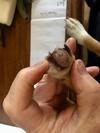Summary:
"There are many possible causes of dog nail problems and diseases. These can be caused by injury, trimming too close to the quick causing bleeding, infection, vascular insufficiency, defects in keratinization (cell growth), congenital abnormalities, neoplasia, immune-mediated disease and infection.
Unlike other areas of dermatology, veterinary knowledge is more limited when it comes to nails, often resulting in a diagnosis of no known cause for a problem. If the veterinarian suspects a cause, then an experimental approach is used where the response to the treatment confirms the cause. Depending on the problem, it can take months for normal nail growth to return."
Causes of Dog Nail Discoloration and Disorders
There are many types of dog nail problems that result in lesions on the nails. These include:
- Anonychia: absence of claws (usually congenital)
- Leukonychia: whitening of the claw
- Macronychia: usually large claws.
- Micronychia: unusually small claws, often shorter or
narrower than normal - Nail Length: Long nails can change the way a dog walks and put pressure on their joints.
- Onychalgia: claw pain
- Onychauxis: Hypertrophy of claws
- Onychia (onychitis): inflammation in the claw unit;
usually in the matrix - Onychoclasis: breaking of the claws
- Onychocryptosis: ingrown claw
- Onychodystrophy: abnormal claw formation (also called symmetrical lupoid onychodystrophy)
- higher incidence in German shepherds, rottweilers, giant schnauzers, Doberman pinschers
- mean age 3 to 8 years
- Causes:
- Acromegaly: abnormal enlargement of the limbs
- Zinc responsive dermatoses
- Inherited abnormalities
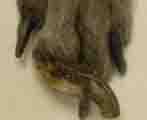
- Onychogryphosis: hypertrophy and abnormal
curvature of claws - Onychomadesis: sloughing of the claws
- higher incidence in German shepherds, whippets, English springer spaniels
- cause by:
- injury or trauma
- infection
- immune mediated diseases such as pemphigus (blisters), bullous pemphigoid, medications, symmetrical lupoid onychodystrophy (shedding of the nails only to have them grow back malformed
- vascular insufficiency (inadequate blood flow), cold agglutinin disease (abnormal clumping together of red blood cells)
- Unknown cause (idopathic)
- Neoplasia (cancerous growth)
- Treatment
- Antrimirobial soak
- Treatment of any underlying cause
- Onychomalacia: softening of the claws.
- Onychomycosis: fungal infection of the claws.
- Caused by the fungal parasite Trichophyton mentagrophytes, commonly all over the body
- Onychorrhexis: longitudinal striations associated with brittleness and breaking of the claws.
- Unknown cause, with the highest incidence in Dachshunds.
- Injury
- Infection: dermatophytosis or leishmanisasis
- Treatment:
- Repair nail with fingernail glue
- Any splintered pieces are removed
- Onychopathy (onychosis): disease or deformity of
the claws - Onychoschizia: splitting and/or lamination of claws,
usually in the horizontal plane at the free edge - Paronychia: refers to inflammation of the skin around the finger nail.
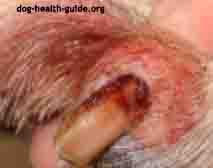
- Causes:
- Infection caused by bacteria, fungus (dermophyte), yeast (mallessezia, candida), demodectic mange (demodicosis) or leishmaniasis (infection caused by protozoa).
- Immune mediated disorders such as pemphigus (skin blisters), bullous pemphigoid, drug related skin eruptions, symmetrical lupoid onychodystrophy
- Neoplasia (tumors)
- Arteriovenous fistula: abnormal channel between a vein and an artery
- Treatment: Treated with removal of the Nail plate. The paw is soaked in a antimicrobial.
- Tears (see dog bleeding and tears).
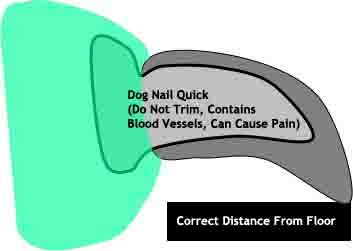
Symptoms
Symptoms of dog nail problems include:
- Bleeding
- Lameness
- Pain
- licking the feet or nails
- Swelling
- Erythema
- Discharge in the nail area
- Nail deformity or tears
- Nail discoloration
- Dog nail bleeding
- Nail loss
- Tenderness when walking
Diagnosis
A veterinarian will take a medical history and perform a clinical examination.
History:
- Age and sex of dog
- Breed disposition to nail problems
- Exercise and cleaning routine
- Were dog nail disease symptoms sudden (acute) or did they progress slowly
- Were other pets effected (if yes, it could be a case of dermatophytosis or fungal infection)
- Number of paws affected
Clinical Exam and Indications:
The clinical examination will involve the entire dog. There may be other skin lesions or signs that indicate a wide spread problem. Problems in the mouth membranes, vulva, prepuce and anus may indicate diseases such as bullous penphigoid, vulgaris or pemphigus.
Problems in the nose, lips, ears (pinnae) and perineum indicates an autoimmune disease. These can include discoid lupus erythematous,or pemphigus foliaceus.
If only one nail is effected, then the problem could be a tumor (neoplasia), bone problem or an injury. If several paws are affected the veterinarian will explore dog nail problems such as nutritional deficiency, keratinisation problems, endocrinopahty and immunomediated diseases.
Tests
There are several tests to detect the various dog nail diseases. These include:
- Cytological tests to look at the formation, structure and function of nail cells
- Claw skin scraping to look for Demodex mites
- Fungal cultures
- Bacterial cultures
- An elimination diet if the veterinarian suspects allergy as the cause.
- Blood tests and urinalysis to rule out diseases that impact the entire body
- X-rays of the paws to rule out osteomyelitis, which is a bacterial infection of the bone that leads to inflammation
- Biopsy to test for neoplasia (cancerous or malignant tumors)
Other Possible Causes (Differential Diagnosis)
- Injury or cancer that impacts one nail
- Systemic disease that has nail problems as a symptom
- Immune medicate disorders (most cases involve some type of skin lesions)
Treatment
In the case of nail injury, the veterinarian will clip the injured area and clean the claws. If the nail is fractured, the area will be soaked every 12 hours in an antiseptic.
For bacterial infections a dog will be given an oral antibiotic, with the choice of medications dependent on test results.
Dog nail fungal infections (onychomycosis) are treated aggressively since the disease often returns if not completely eliminated. Treatment can last from 1 to 3 months or more to achieve complete nail regrowth.
For immune system related problems oral prednisone is used for 2 to 9 weeks, followed by a decline in dosage.
Neoplasia is treated with surgical removal of the nail and any cancerous ares such as amputation of the toe or leg. Chemotherapy and radiation is prescribed if indicated.
See above (under causes) for treatment of paronychia, onychomycosis, onychorrhexis and onychomadesis.
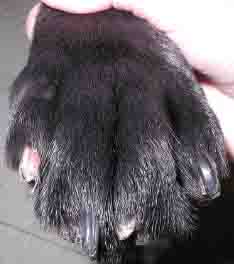
Symptoms: Patient visited Vet with symptoms that included paw licking and nails that were falling out.. On examination nails were splitting and broken. Tests confirmed a diagnosis of symmetric Onychodistrophy and Secondary Paronychia.
Treatment:
- Prednisolone: 1 mg/kg/day by mouth tapered every five days to 0.3 mg/kg every other day
- Tetracycline: 500 mg/dog/day by mouth
- Niacinamide: 500 mg/dog/day by mouth
- Fatty acid supplements omega 3 (EPA and DHA) and omega 6 (LA and GLA): 180 mg of EPA and 120 mg of
- DHA per 10 pounds of body weight once daily by mouth
- Diluted chlorhexidine solution: twice-weekly paw soaks
- Photo Credit: University of Minnesota
Treatment Results: The dog was seen 1 month after treatment began followed by office visits in 2 to 3 month intervals until the dog nail problem was under control. At the 1 month mark the chlorhexidine paw soaks and prednisolone was no longer necessary, since symptoms such as paw licking, sensitivity and pain were no longer a problem. Nails not only started to grow back, but appearance was greatly improved. At the 8 month mark the medications niacinamide and tetracycline were stopped. The patient continued taking oral essential fatty acids. The patient no longer suffered from dog nail loss.
Have A Question about Dog Nails For Our Vet? We'll Answer It For Free
Do you have a question or comment? Share it!
Our editors will pick 1 question to answer each week. Please include your dog's age, breed, medical history (medications, when the problem first started) and if possible, a picture of the nail condition.
We will do our best to get back to you quickly (it depends on how many questions we receive each day). If you do require an immediate response we suggest using this online dog veterinary service that is available now.
Other Reader Dog Nail Related Questions and Vet Suggestions
Click below to see contributions from other visitors to this page...
Chihuahua With Swollen Toe But No Pain Not rated yet
My Chihuahua has a swollen firm to touch no pain toes for over a week.. was painful at first, and licked it constantly, i soaked it in diluted betaden, …
Dog With Ugly Deformed Long Curved Nail Not rated yet
My dog is at least 10 yrs. old and developed an ugly nail that curves over his other toe. The dog nail is scaly and gross.
The Veterinarian wants …
References for Dog Nail Problems
(1) Washington State University
(2) Masassezzia Infections In The Dog, Gustavo Machicote Goth
Vilanova Veterinaria Clinic Vilanova
Canine and Feline Diseases
Dr. Maite Verde, DVM, PhD
Dermatology Services. Teaching Hospital. Veterinary Faculty
University of Zaragoza. Spain
Ischemic Skin Disease in Dog
Peter J. Ihrke, VMD, Diplomate
ACVD
Professor of Dermatology, Chief
- Dermatology Service, VMTH
Department of Medicine &
Epidemiology
School of Veterinary Medicine
University of California
Author : Jeff Grill

